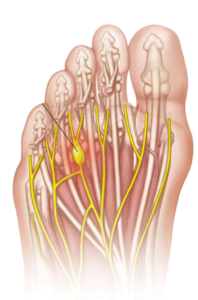Taking a step in the Right Direction: Podiatry Insights on Neuromas
April 26 2023
Foot neuromas are a relatively common condition, with an estimated occurrence of up to 10% in the general population.
Dr. Altepeter discusses the risk factors, symptoms, diagnosis, and treatment options. Dr. Joe Altepeter is a podiatric physician and surgeon practicing in Southwest Florida. Board Certified: American Board of Foot and Ankle Surgery.
OVERVIEW:
- What is Morton’s neuroma?
- Symptoms
- Causes
- Diagnosis
- Treatment
Do you get the feeling like your sock is folded over or there’s a pebble in your shoe, only to find nothing there? Does the ball of your foot sometimes hurt with a sharp, burning pain going into the toes? You could have something called Morton’s neuroma. It’s a common foot condition that affects 1 in 3 people.
What is a Morton’s Neuroma?
Morton’s neuroma is a painful condition of the ball of your foot. The term neuroma means a benign (non-cancerous) nerve tumor. However, Morton’s neuroma is not really a tumor. Rather, it is a thickening of the tissue surrounding the nerve that goes into your toes.
Morton’s neuroma most commonly occurs between the third and fourth toes because space here is narrower compared to the other spaces between the toes. The symptoms are usually present on one side. Rarely, both feet may be affected.
Both men and women can develop Morton’s neuroma, but it is up to 10 times more common in women compared to men.
What Does a Morton’s Neuroma Look Like / Feel Like?
When you look at the underside of your toes, you may not see or even feel anything. That’s because Morton’s neuroma is not actually a tumor. The most common Morton’s neuroma symptoms include:
- The sensation of a lump or feeling like there’s a marble in your shoe.
- Sharp, burning pain in the ball of your foot.
- Stinging, burning, or numbness in the toes.
- Pain between the toes that is aggravated by walking or wearing tight-fitting, high-heeled footwear and relieved by taking off the footwear and resting.
What are the Causes of Morton’s Neuroma?
A Morton’s neuroma develops due to pressure, irritation, or injury to the nerves that go into your toes. Some of the risk factors for Morton’s neuroma are:
- Wearing high-heeled narrow toe box, or ill-fitting shoes that put pressure on the ball of your foo
- Wearing tight shoes for sports like rock climbing or skiing that put pressure on your toes.
- Participating in high-impact sports like running that cause repetitive trauma to the foot.
- Foot deformities like bunions, flat feet, high arches, and hammertoes are risk factors for Morton’s neuroma.
How is Morton’s Neuroma Diagnosed?
There is no specific Morton’s neuroma test. We diagnose the condition based on your history and physical examination. Sometimes, we may inject a local anesthetic into the area to see if it helps? We may also get x-rays to rule out other causes of your symptoms, such as a stress fracture, foot deformities, or arthritis. A Morton’s neuroma ultrasound may be ordered to aid diagnosis. An MRI is sometimes needed to rule out other conditions.
Does Morton’s Neuroma Go Away?
A Morton’s neuroma does not disappear on its own. However, your symptoms may come and go depending on the type of shoes you’re wearing and how much time you’re spending on your feet. What happens if Morton’s neuroma goes untreated? It’s difficult to say. Your symptoms could get better or go away completely. They could also get worse, causing you to limp or forcing you off your feet. Our recommendation is it’s best not to ignore foot pain that lasts more than a few days.
What Are the Treatment Options?
Morton’s neuroma treatment includes one or more of the following:
- Wearing low-heeled, wide-toed, comfortable footwear with good arch support.
- Cutting back on high-impact activities like running and dancing.
- Metatarsal pads or crest pads to provide cushioning.
- Orthotics (shoes inserts) to correct mechanical imbalances that may be putting on the area.
- Anti-inflammatory medications and icing for symptom relief.
- Injection of anesthetic and steroid medication into the area.
- Morton’s neuroma exercises to stretch and strengthen the foot.
In severe cases, where symptoms do not get better with conservative treatments, it may be necessary to perform surgery for Morton’s neuroma. The surgeon will either remove the nerve or cut away nearby structures to relieve pressure on the nerve. How long does it take to recover from Morton’s neuroma? If you have surgery, you may need to be on crutches for about 3 weeks. Complete recovery can take up to 6 weeks.
 The most important thing you can do to prevent Morton’s neuroma is to wear properly fitted, comfortable shoes as far as possible.
The most important thing you can do to prevent Morton’s neuroma is to wear properly fitted, comfortable shoes as far as possible.
If you already have symptoms and suspect your foot pain is due to Morton’s neuroma, you should get checked out.
Contact Dr. Altepeter’s office at (239) 430-3668 (FOOT) or visit www.NaplesPodiatrist.com to schedule an examination.
—————–



 Fax: (239) 692-9436
Fax: (239) 692-9436 Tel: 239-430-3668
Tel: 239-430-3668
